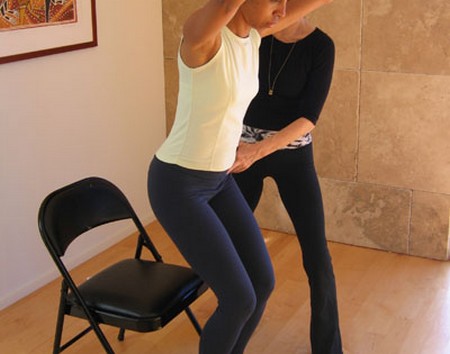The spine is the core of all movement, the central armature of our physical structure, and determines our human form. The shape and position of the spine also convey visual signals to the audience about a character’s condition and state of mind; compare the bent and compressed spine of an old weary peasant woman with the whippy, proud, elegantly and seductively curved back of the ballerina. The following exercises must be done gently, not forcefully. Stop immediately if there is great strain or discomfort.
1. Stand upright and let the head fall gently onto the chest; let the spine slowly melt from the top. Allow the arms to hang freely. As the body curves down let your knees bend slightly. Now breathe in and stretch upward with your whole body and arms, but don’t look upward, just let your head rock gently on the top of its column. Repeat this several times, trying to feel where your spine is; a man with a belly may become aware that his back is permanently hollowed from the weight of that gut, and an actor with poor sight may find that his head is craned forward on his neck.

2. You need to build strength and flexibility. It requires supple musculature to keep the spine straight, though not rigidly straight, as it’s a flexible string of bobbins with elastic pads in between. The spine curves slightly in three places: a convex curve from mid-back to neck, a concave curve in mid-back, and another convexity as the tail, or coccyx curls under the pelvis. You strengthen the spinal muscles by using them. Do this version of a sit-up. Sit on the floor, with the legs spread slightly, knees slightly bent and let the upper body fall gently forward as in the previous exercise. Breathe in slowly and uncurl the body until it’s upright. Waggle the head on a vertical axis gently from side to side; now let the spine melt from the bottom until your whole spine is as flat as it can be on the floor. Repeat this a number of times, trying to make the process quicker and smoother.
3. Kneel on all fours. Arch your back as high as you can, like a cat, position of the spine by raising your head as high as you can and sticking your tail in the air to make the deepest possible hollow in the back. Now slowly raise the middle back and lower the head until the back is absolutely level and flat and your neck is in line with the spine. Repeat this arching and curving exercise slowly, gradually increasing speed. Remember that all strengthening and flexing exercises for the back and spine must be smooth, not jerky. These have a lot in common with the exercises prescribed by physiotherapists for rheumatic conditions of the spine.
4. Where’s your pelvis? A vivid image is of a bejeaned girl, standing with one hip thrust out; another is of a beer-bellied lad with a hollow back, waddling home from the pub. Both of these are inelegant postures, since the support for the part of the body for standing, walking, sitting, dancing, the pelvis, is unnaturally tilted, and the muscles which should ensure that the pelvis is mobile but in the right position have become adapted to a wrong position. Just as comedy starts with the feet, love scenes and embraces start with the pelvis, apparently in contact with another pelvis, and lips only appear to touch – that is, there mustn’t be a transfer of make up from one to another. The screen kiss is another matter altogether and usually has to be a real smacker.
Try the following exercise.
Wearing only a leotard, stand in front of a long mirror, facing it, the feet about twelve inches apart. Feel the floor with your feet, toes, heels, and the ball of the foot. Now look at yourself; is one hip sticking out more than the other? Are your shoulders level? If not, flex your hips till you are in alignment and turn sideways. Hollow your back and lift your tail up as far as you can, at the same time lifting the head and arching it back, and bending slightly at the knees. Very slowly curve the spine in the opposite direction, let the head fall forward, tuck the tail under, and let the back shape into a convex curve. Hold this position for a moment and as you take a deep breath, gently straighten up from the head and down the spine, and straighten the legs, thinking the pelvis into that neat, tucked-under position. Now bend the knees, letting your body down vertically, remembering to keep the spine and pelvis in the same position as when standing. Now with your thigh muscles, rise to a standing position. Repeat this exercise several times, regularly.